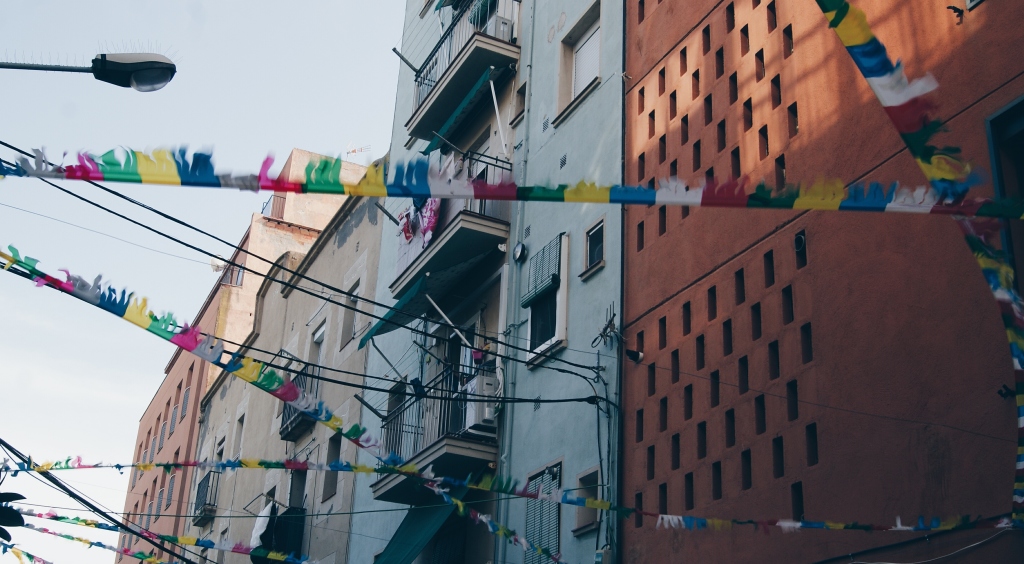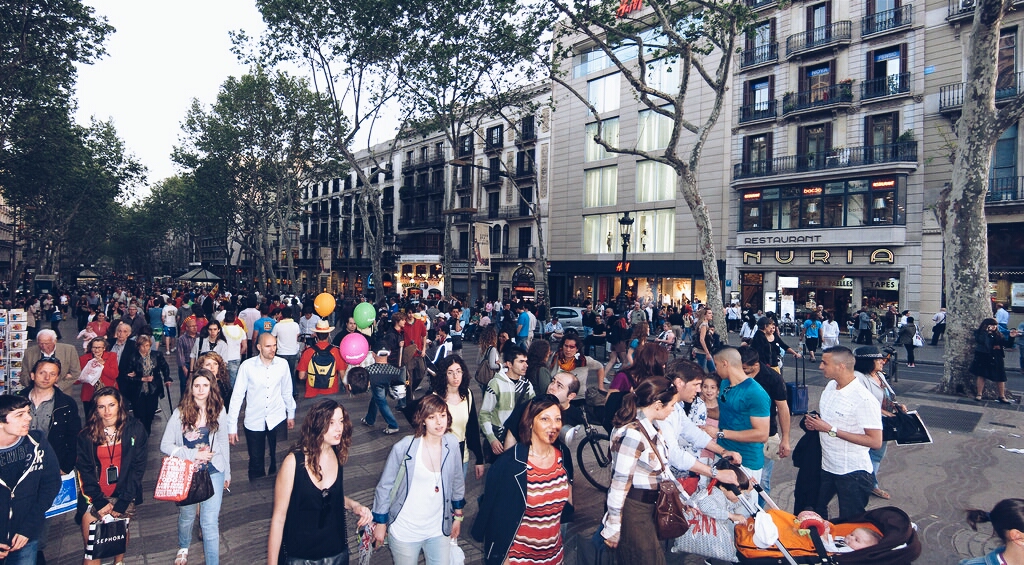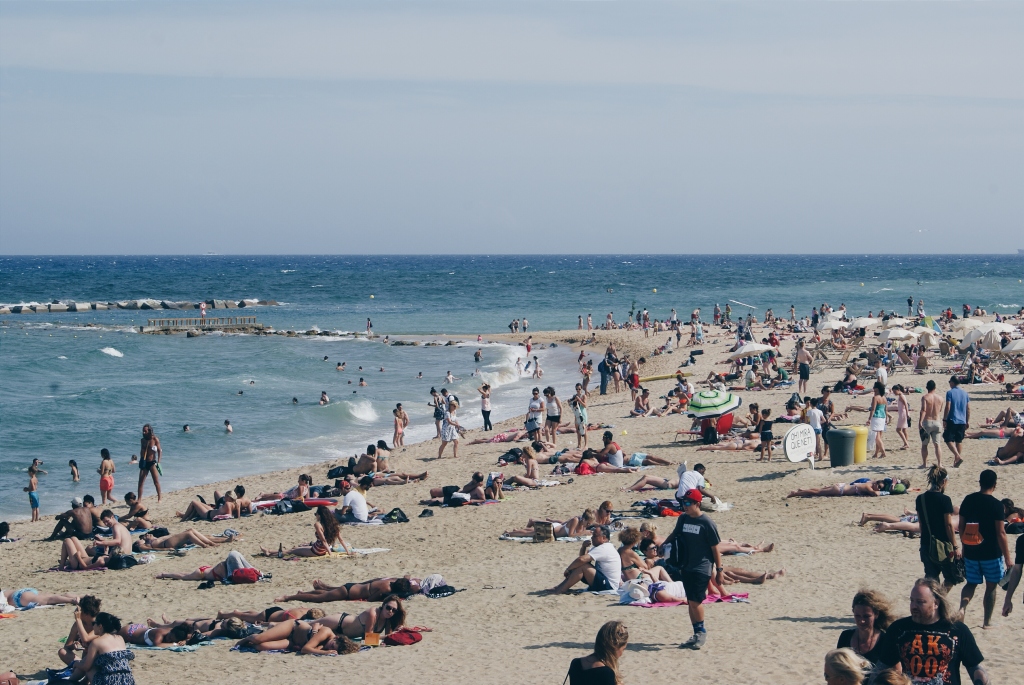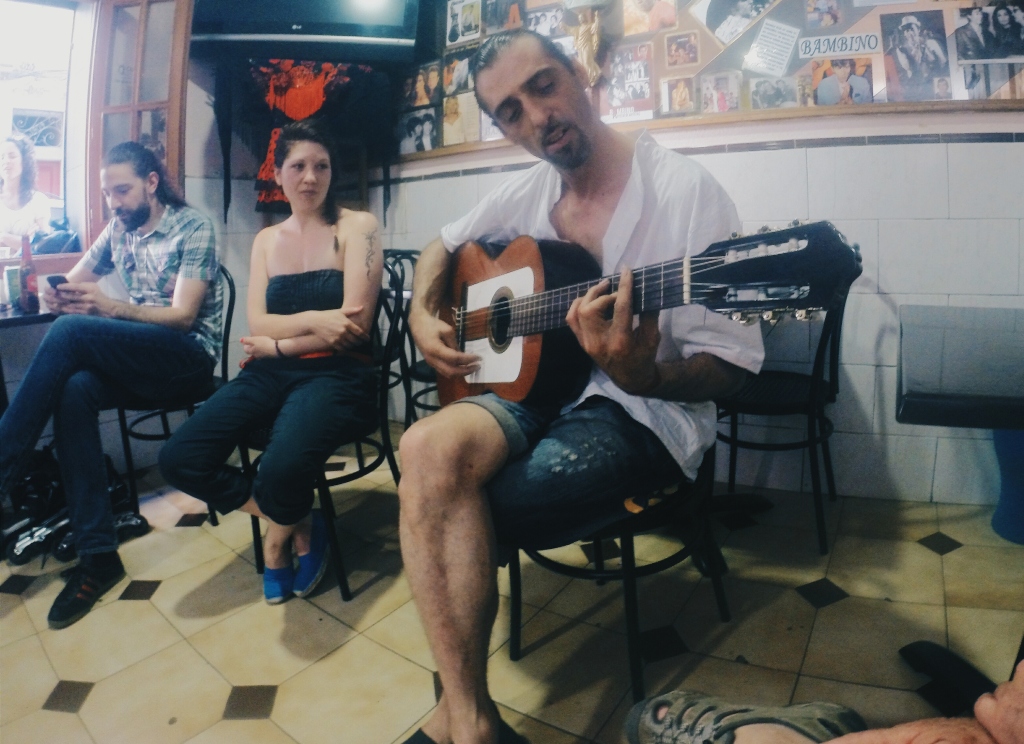Barceloneta – The Last Barrio
Barcelona? It’s a theme park. “The world’s best shop”
– Llum Ventura, resident of Barceloneta. Quote from Bye Bye Barcelona

In 1993, 2.4 million people visited Barcelona. In 2013, 20 years on, that number rose to over eight million.
Newspaper stands line the centre of La Rambla, Barcelona’s most famous avenue. These stalls sell postcards, t-shirts, magnets, keyrings, and other souvenirs, and a handful sell flowers.
Street performers stand on boxes, dressed up in elaborate costumes, waiting for a curious visitor to toss a coin into their hats. Just a few metres away will be another performer, then another after that, and another after that.
Towards the south end of La Rambla, artists set up shop, sitting on stools and patiently waiting for the next customer. Around them are their other works, sketches of Barcelona scenes, famous faces, and caricatures of tourists gone by.
Streets running off La Rambla are tributaries of much the same calibre; the stream of tourism flows deep into El Gòtic, Born, and Raval, the cluster of districts that surround Barcelona’s infamous passageway.
Walking down La Rambla undisturbed in high season is an art form. Plodding tourists take their time to drift up and down, rendering it impossible to get anywhere in a hurry. Many locals say they never set foot on La Rambla, and during the time I lived here in 2012, even I avoided this nuisance at all costs.
Arriving in Barcelona for the first time you will naturally gravitate towards these districts (locally known as barrios), and I wouldn’t blame you. All the major sights and stories you want to hear as an introduction to Barcelona – most of the things the guidebooks tell you to visit – are collected here in the Ciutat Vella, the Old Town.
As you spend more time in Barcelona, staying longer than a few weeks perhaps, you may start to notice a few things; chalkboard menus outside cafés are penned in English, every other word you catch in passing conversation is spoken in English, and stores repeat themselves – more and more of the same ‘I Heart BCN’ trinkets. Glancing at the faces of people that pass you by, only a handful are Catalan. The locals are outnumbered.
It will leave you asking one question.
Is this the real Barcelona?
The Mass Tourism Effect
The unfortunate truth is that, as a visitor, it’s very hard to find the ‘real’ Barcelona. These central neighbourhoods don’t belong to the born and bred anymore, they belong to the tourists. Authentic culture is being crushed by the endless boom of tourist-focused hotels and restaurants, and life becomes intolerable for residents. These issues are documented in the short film Bye Bye Barcelona, which talks to locals about tourism issues in this city and touches on how they could be resolved.
This manufactured culture is an extremely sad reality I’ve come to observe during the last few times I’ve returned here since moving away. I’ve spent a lot of time in Barcelona in the last two years, and even I would struggle to tell you where to find something truly authentic.
That said, I believe there is one shred of hope left. One district where something resembling Barcelona local life still remains.
Barceloneta – the last barrio.
An Everyman’s District
Barceloneta is a neighbourhood flanked by the beach and El Born, east of La Rambla. In the 18th century, city planners decided to build a park in the centre of town, what is now Parc Ciutadella. In order to do this, they moved the residents of this space down to the beach, effectively rendering them homeless. Communities set up tents along the sands, and when they realised over time that they’d be there for the long-haul, they created their own barrio. Barceloneta was born.
Tightly packed to fit in all of its residents, Barceloneta is a gridded series of cramped apartment buildings. This was the neighbourhood for fishermen and workers, the less affluent of Barcelona. Today, its convenient location immediately next to the beach makes it a sought-after place to live, but Barceloneta’s humble roots remain grounded.
In a Barceloneta’s square, old ladies stop young mothers in the streets, cooing and squeezing the cheeks of their newborns and asking after their health. Old gents park themselves on public benches for the day, assimilated into the scene around them, smoking and grumbling. Children play without care while their parents keep half an eye out, the rest of their attention spent on catching up with town talk. Small, no-frills Catalan bars are dotted around, drawing in a local crowd to be replenished with cerveza and a humble selection of tapas. In the dead of night, the streets are respectfully still.
More Than a Coastline
For most tourists, Barceloneta is merely a passageway to the beach. Hopping off at the Barceloneta metro stop, it’s just a short amble down Passeig de Joan de Borbó before you get to the crowded coast. Restaurants along here are plastered with photos of paella and sangria, and staff stand outside holding menus, waiting to drum up business by pouncing on the next tourist that walks by. The only other street on which you may find tourist groups in Barceloneta is Carrer de l’Almirall Cervera, a wider avenue that some use as a shortcut to the sand.
The travellers here are blinkered, consumed by tunnel vision. Most only concern themselves with getting to the ocean, and just a tiny fraction take the time to look around and into inner Barceloneta.
I should know – I used to be one of them. During a visit in 2009, I too was entirely unaware of the low-key community of locals living here. Having stayed in Barceloneta for a month during a trip earlier on in 2014, my eyes were opened. Something special is here that I had not seen elsewhere in the city.
One Saturday afternoon, I was invited by friends to Bar Leo. Each week, at around 5pm in this tiny local bar, two musicians pull up chairs and play traditional Catalan songs for just one hour. The majority of the locals who tune in each week know every word, and sit around the couple to sing along.
There is no cover charge or entrance fee – the singer walks around the bar with an upturned hat once or twice during the hour, which by the end of the round is usually full of notes and coins. As everyone starts to get into the swing of the festivities, people get up and dance in the centre, swinging hips and clapping hands.
Very few tourists are found here. Sometimes you’ll see the odd straight-off-the-beach pink-tinged traveller linger in the doorway, intrigued to find out where all the noise is coming from. If they’re brave enough, they wander in, take a few pictures or a short video, and toddle back out again. This musical performance has far fewer bells and whistles than the average tourist in Barcelona is used to, so to most it looks uninteresting.
I had never seen anything like it before in all my time here. This hour, this perfect hour in Barceloneta, is the only time I think I’ve come close to authentic Barcelona.
It resonates in the words of the bar’s owner, Leo – ‘Para mi, es familia.’
For me, it is family.
Tread softly, because you tread on my dreams
– The Cloths of Heaven, W.B. Yeats
While I can still see local life here in this barrio, some locals in Barceloneta believe their home is already being forgotten. The same woman that calls Barcelona a ‘theme park’ in my opening quote also talks about how Barceloneta is currently being taken over. ‘There are no locals here’, she says.
Pointing to a sleek bar named Surf House, next to where her interview is filmed, she continues. ‘For example, this opened some time ago, and it used to be a very local bar. It’s very nice, of course, but who is it aimed at? That’s what Barceloneta is turning into.’
I can certainly see it creeping in. Barceloneta is fenced on all sides by streets fashioned for tourists, and the neighbourhood is teetering on the edge of being washed away. While the streets around the outside are already lost, within the depths of the barrio, the parts that seem unremarkable to visitors and thus not worth exploring, hope still lingers.
Barceloneta locals are part of a true community, and fiercely proud of it. They are the bar owners, the restaurant runners, the mothers, sons, and the grandparents who just want their home to stay that way – their home.
I would encourage visitors to explore Barceloneta, but that encouragement doesn’t come without warning. This is an area that needs to be preserved. If there’s any authenticity to be found left in Barcelona it is here in Barceloneta, and it needs to be kept alive. If some locals can already feel it slipping away, this warning is even more imperative.
Stumbling tourists after too many cocktails are not welcome here, and unlike the neighbourhoods towards the centre, the locals will happily tell you so. Barceloneta is a place to be curious about Barcelona, to be an observer. It is a place to tune into local life and not overlook it.
Visit the barrio, and respect the barrio.
Tread softly. Barcelona is here.
Have you experienced the mass tourism effect in Barcelona? Have you ever visited Barceloneta?





As a born and bred Barcelonian, while I can share some of the thoughts you display here, I totally disagree about not being able to find places where “the real Barcelona life still remains”. Barcelona has 10 districts, divided into 73 neighbourhoods (‘barris’ in Catalan, the local language) and from those, maybe 10 reflect indeed many of the things you said in this post, but most of the others, remain pretty much as they were 40 years ago, when I was little. Sarrià, Sant Gervasi, Poble Nou, El Putxet, Gràcia, Horta… I could name many more areas where local life thrives away from mass tourism. And in fact, La Barceloneta wouldn’t be arguably one of them, not only because is full of tourists most of the year, but also because too many of its flats are now in the hands of foreign investors that short rent them all year round. Thus, the neighbourly feeling has ceased to be… since, as a resident of the neighbourhood, one doesn’t know most of his/her neighbours anymore. Nice article, but other than nostalgy I feel it’s not accurately displaying the reality. Just saying.
Thanks for your comment, Enric! It’s great to get a local’s perspective and good to hear that you think there are still a good few neighbourhood’s that remain untouched. That wasn’t my personal experience of the city (I lived in Gràcia and certainly didn’t feel it there) but hey, if there are places you are seeing as the same as when you were little, that’s good news! It’s been a few years since I wrote this post and visited Barceloneta, so maybe there are more tourists now, and yeah it’s sad that the buildings are rapidly being bought up. Short terms rentals are certainly not helping! Thanks again for your perspective.
[…] Barcelona in the past – one of them main reasons I left was because I found the city too busy and struggling under the weight of tourists. But I do like to pop back every now and then, because something about Barcelona swept me away when […]
[…] Gotta Keep Movin – Barceloneta – The Last Barrio […]
Though I’ve been to Barcelona and “done” La Rambla and Gaudí I hadn’t heard of Barceloneta before now. It sounds like a good reason to go back and take a closer look at the city. Thanks for an interesting and informative article. I’ve learned something. 🙂
What a wonderful post! It brought back fond memories and stirred me to return. I was in Barcelona in 1970 and loved it. Friends I met up with while there suggested we go to Barceloneta for dinner, and after all these years it remains one of the brightest memories of my stay there. Even though we only visited the “restaurant row,” I loved sitting out on the sand-edged terrace, indulging in the stereotypical paella and sangria and watching the kids from all the families dining around us run around on the beach. I have wondered many times over the years what happened to that special place. Now I know how much more special it really is than I knew then. Luckily, I will return to Barcelona next spring. A trip to Barceloneta, not just for a meal on the beach but for a stroll through the neighborhood, a long sit on a bench in a square, and a quiet inhaling of Old Barcelona is at the top of my city list. Thank you!
Thank you for your thoughtful comment, Donna. Gad to hear you’ve seen a little of Barceloneta already, and enjoyed it, and I’m happy to inspire you to dive in next time! Have a good dig into the barrio and see what you find – it will at least be a little peace and quiet away from the crowds. Have a wonderful time!
I totally agree with you. I was in Barcelona last year and could NOT believe the difference from when I first visited in 1998. Great post and perspective, Emma! Nice photos too!
[…] of you who have visited Barcelona on a short break will probably have ended up at Barceloneta beach at some point. At the end of a strip of bars and restaurants, it’s the closest beach to the […]
Interesting…I’ve been to Barcelona and oohed and ahhhed at the Gaudi district. No, have never heard of Barceloneta and it sounds fascinating.
Thanks for this insight Emma – hopefully I will get the opportunity to go to Barcelona again sometime and experience this.
Well as I said, Bex – you’re not the only one who hasn’t really heard of this district! Hope you get to go back soon and take a look around 🙂